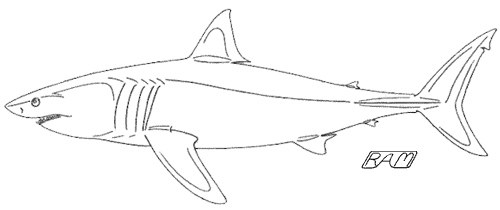Giants: White Shark
(Carcharodon carcharias)
Maximum Length = 23.4 feet (7.1 metres)
Maximum Weight = 2.5 t (2.3T)*

Made famous by the movie JAWS, the White Shark — often called the Great White Shark — is the largest actively predacious shark and the only one to feed on warm-blooded prey. The Whale (Rhincodon typus) and Basking (Cetorhinus maximus) Sharks grow larger, but feed mostly on tiny planktonic organisms. Although they are best known as man-eaters and predators of marine mammals, White Sharks rarely consume humans and prey primarily on fishes (including other sharks). White Sharks also feed on pinnipeds, whales, dolphins, squids and crustaceans. Like some of its lamnoid relatives, the White Shark is able to maintain its body temperature warmer than the surrounding water temperature, an ability that enables it to extend its range into cold, food-rich boreal seas. Nowhere common, the White Shark is fairly abundant in cool coastal waters at certain locations around the globe — including, South Africa, South Australia, northern California, New Zealand, New England, and in the Mediterranean. Traditionally thought of as a simple, stupid, solitary hunter, recent research is demonstrating that the White Shark is curious, exploratory, and intelligent, that it employs different predatory strategies for different types of prey, and is surprisingly complex socially — at least under certain contexts. Due to centuries of persecution by humans, the White Shark is now protected in many areas, but global conservation efforts have stalled for lack of data on current population sizes and dynamics. Thanks to countless television documentaries, the White Shark is becoming more widely appreciated as wildlife worthy of protection, but there remains a great deal we do not know about this infamous and spectacular predator.
* 1 ton = 2,000 pounds: 1 tonne (T) = 1,000 kilograms
